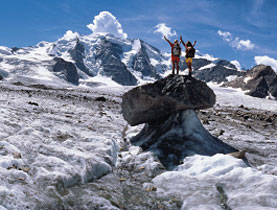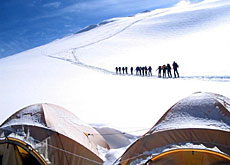Why Heidi didn’t have altitude sickness

Children are less susceptible to mountain sickness – a common and unpleasant effect of high altitude exposure – than previously thought, a Swiss study has found.
Researchers came to the conclusion following an assessment made on top of the 3,450-metre-high Jungfraujoch mountain in the Bernese Alps. Preventative drugs against the illness in youngsters may not be necessary, they say.
“Acute mountain sickness is by far the most frequent problem in people who go to high altitude and rather surprisingly there is very little information about its prevalence and its outcome and there have been absolutely no control studies so far,” said Urs Scherrer, the professor from Lausanne University Hospital’s department of international medicine who led the research.
The study, published in the latest edition of the American journal Pediatrics, was particularly concerned with the effects of the condition in children, as there are very little data on this.
Acute mountain sickness is caused by a shortage of oxygen after ascending to high altitudes, normally of more than 2,400 metres.
It can result in hyperventilation, nausea and exhaustion. In extreme cases, it can progress into high altitude cerebral or pulmonary edema – swelling of the brain or lungs – which can be fatal.
The condition is often associated with mountaineers but anyone spending time at elevation can suffer from it.
Up on high
Scientists decided to test children and adolescents after rapid ascent to 3,500m – an altitude at which major tourist destinations and some airports are located throughout the world.
In all, 48 children and adolescents – 20 girls and 28 boys aged ten to 17 – were taken to the Jungfraujoch high-altitude research station in the Bernese Oberland.
One of Switzerland’s most important tourist attractions, it was reached by the children after a two and a half hour train ride.
The young people, all with no previous high altitude experience, were assessed at six, 18 and 42 hours after their arrival. Prevalence of acute mountain sickness during the first three days was 37.5 per cent.
“Acute mountain sickness after rapid ascent to 3,500m in children is less frequent than many people would have thought,” Scherrer said of the results.
“It evolved favourably in the vast majority of these children and most of them didn’t even need drugs to treat symptoms associated with acute mountain sickness,” he told swissinfo.
Two thirds of the children with the condition developed symptoms during the first few hours at high altitude. These symptoms decreased progressively during the next two days as they became acclimatized.
Rates were similar for both sexes and nobody was evacuated to a lower altitude. Five needed treatment for their symptoms and responded well.
Brain matters
“There have been studies in adults in Nepal, for example, where they looked at acute mountain sickness after arriving by airplane at the same altitude as our study and there the prevalence of acute mountain sickness was between 80 and 90 per cent in adults. That’s much higher than for the children,” Scherrer said.
There has been speculation that children are more prone to acute mountain sickness because when a rapid ascent is made, the brain swells owing to the lack of oxygen and presses against the skull.
As the brain shrinks with age, adults are generally considered better able to deal with brain swelling than young people.
The Swiss study might suggest that children actually may be better able to cope with rapid ascent to 3,500m than adults.
“But it’s clear that this has to be tested directly by exposing children and adults the same way,” Scherrer told swissinfo.
Overall, the findings suggest that for the majority of healthy non-acclimatised children and adolescents, travel to 3,500m is safe, and preventative treatment for acute mountain sickness is not needed.
“It is sufficient to treat symptoms if they occur and are severe,” said Scherrer.
swissinfo, Isobel Leybold-Johnson
The condition occurs because the body is not getting enough oxygen. At altitude, the percentage of oxygen in the air remains constant, but since air pressure decreases, fewer oxygen molecules are breathed in. Oxygen is essential for muscles and organs to function properly.
Altitude sickness normally occurs above 2,400 metres. It is normally associated with mountaineers, but anyone can be affected. High altitude flights can also be a cause or going on high walking or trekking holidays.
Symptoms include tiredness, headache, nausea and unsteadiness and can appear after around 6 hours. If the person remains at the same height, the symptoms normally go away after a day or two.
Vomiting, chest pains and shortness of breath indicates a more severe treated condition – high altitude cerebral or pulmonary edema – usually appearing after 1 to 2 days. Severe cases can result in death if not in time.
The Swiss research also involved scientists from Bern University Hospital and Basel University.
It was published in the January 1 edition of the American journal Pediatrics.
However, a study carried out by Zurich University at the top of the Jungfraujoch in 2006, testing parents and children, came to the opposite conclusion – i.e. that children were more prone to acute mountain sickness.

In compliance with the JTI standards
More: SWI swissinfo.ch certified by the Journalism Trust Initiative














You can find an overview of ongoing debates with our journalists here . Please join us!
If you want to start a conversation about a topic raised in this article or want to report factual errors, email us at english@swissinfo.ch.